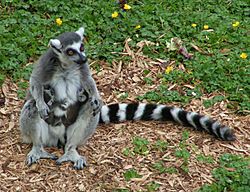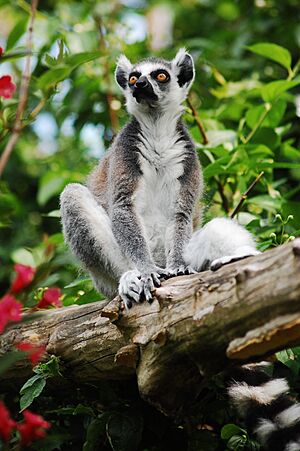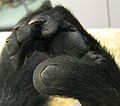Lemur facts for kids
Quick facts for kids Lemurs |
|
|---|---|
 |
|
| Ring-tailed lemur (Lemur catta) carrying twins | |
| Scientific classification | |
| Kingdom: | |
| Phylum: | |
| Class: | |
| Order: | |
| Suborder: | |
| Infraorder: |
Lemuriformes
Gray, 1821
|
| Superfamilies | |
|
|
Lemurs are a special type of primate, but they are not monkeys. The word "lemur" comes from the Latin word lemures, which means "ghosts". There are about 100 different kinds of lemurs, grouped into eight main families.
Lemurs live only on the island of Madagascar. A few species also live on smaller islands nearby, like the Comoros.
Lemurs can be very small, weighing about 30 grams. The largest lemurs can weigh up to 10 kilograms. Sadly, some much larger lemur species have become extinct since people arrived in Madagascar. Usually, the smaller lemurs are active at night (nocturnal), while the larger ones are active during the day (diurnal).
Lemurs are endangered species today. This is because people destroy their homes, called habitats. Also, people used to hunt them.
Contents
What Lemurs Look Like
The Ring-tailed lemur is one of the most well-known types. It has black and white fur with a long, ringed tail. Larger lemurs can be about 1.5 meters tall and weigh around 2 to 3.5 kilograms. Lemurs often move quietly, especially at night. Some lemurs make strange, wailing cries. People think these sounds might be why they were named "ghosts."
What Lemurs Eat and How They Live
Lemurs mostly eat fruit, leaves, and other parts of plants. They live in groups called troops. These troops can have anywhere from 5 to 42 members.
Female lemurs are usually in charge of the group. They stay with the same troop for their whole lives. Male lemurs, however, often move between different troops.
A female lemur carries her babies for about four to five months. She usually has one or two babies at a time. Lemur mothers feed their babies milk until they are about four months old. After that, the babies start to eat solid foods like fruit.
Lemurs spend most of their time living in trees. Some lemurs are amazing jumpers. They can leap from one tree to another with great skill!
How Lemurs Communicate
Lemurs talk to each other using different kinds of hoots and calls. They also send messages using scents (smells).
When a male lemur wants to scare another male away, he does something interesting. He rubs his tail on special smelly glands under his arms. Then, he waves his tail in the other male's face! These smelly contests are sometimes called "stink fights."
- Lavasoa dwarf lemur
- Grey bamboo lemur
- Ring-tailed lemur
- Aye-aye
- Black-and-white ruffed lemur
- Silky sifaka
Related pages
Images for kids
-
The Sahamalaza sportive lemur (Lepilemur sahamalazensis) was identified as a distinct species in 2006.
-
A six-tooth version of the strepsirrhine toothcomb in a ring-tailed lemur, with canine-like premolars behind it
-
Aye-ayes exhibit eyeshine because they have a reflective layer of tissue in the eye, called a tapetum lucidum.
-
Up to 95% of the greater bamboo lemur's diet consists of bamboo.
-
Sifakas are specially adapted to vertical clinging and leaping, so they must hop sideways to move on the ground.
-
Lemurs use scent-marking to communicate. Pictured is a red-bellied lemur rubbing its rump against some smaller branches.
-
Berenty Private Reserve in southern Madagascar is both a popular tourist destination and research location. Alison Jolly began her research here in 1962.
-
The indri is known locally as babakoto, which translates to "Ancestor of Man".
See also
 In Spanish: Lemuroidea para niños
In Spanish: Lemuroidea para niños



















